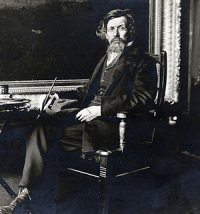George Inness was an American painter in the 1800’s. He was a master at capturing that sort of atmospheric glow we see sometimes in the morning or the evening, or before or after a storm. You can almost hear the quiet morning (or evening) here… birds and bugs twittering away as the light changes. The painting is titled “The Home of the Heron,” and there is indeed a heron tucked neatly in the lower left.
I’ve always really liked Inness’s work, and I think it’s because of that atmospheric quality. And maybe because he portrays places, and moments you’d like to experience. So often, they are quiet and contemplative pieces, which is apropos, because he was a contemplative guy (though, maybe not quiet).

The Home of the Heron (1893)
45″ x 30″
by George Inness
American
Image Source: Wikimedia Commons


Inness was much influenced by philosophical and spiritual ideas, especially about nature and it’s connection to the divine. He was especially interested by ideas of Emanuel Swedenborg, a Swedish scientist-inventor-philospher-theologian of the 1700s (a real genius, who had unique ideas about the spiritual essence of nature – and some pretty wacky one too). Inness was more into capturing the feeling of a place and time – something he might have deemed a spiritual or divine essence – than in depicting unique or well known places. I think he got it!
Inness was well respected, and had a long, successful career. He was the fifth of thirteen children in his family. His father was a farmer. He travelled widely and worked with many great artists of the time.

Inness was an ardent abolitionist. He tried to join a Massachusetts regiment during the Civil War, but failed the physical examination. This got me curious about how fit you had to be to join a regiment. One would think they’d take just about anyone, maybe – maybe not:
The next step was a medical examination to determine physical fitness for service. Each town had its physician for this work. The candidate for admission into the army must first divest himself of all clothing, and his soundness or unsoundness was then decided by causing him to jump, bend over, kick, receive sundry thumps in the chest and back, and such other laying-on of hands as was thought necessary. The teeth had also to be examined, and the eyesight tested, after which, if the candidate passed, he received a certificate to that effect. Via Civil War Home
But perhaps the exams were not so stringent. Another writer notes:
This old soldier’s memory notwithstanding, during the early part of the war filling the ranks of the regiments was more important than the medical readiness of the recruits and physicians often turned a blind eye to many disqualifying conditions. Induction physical examinations used the pass rate as a measure of success ensuring that recruits with all their limbs, good teeth (for tearing rifle cartridges) and adequate sight/hearing would be retained for service. As one regimental surgeon put it, “Many of [the soldiers] ought never to have come out, having broken constitutions or bodily defects which entirely disqualify them for the life of a soldier.”[iii]In fact, some of the examinations were so superficial that women were able to enlist pretending to be men.
So, Inness didn’t pass. Maybe he was a poor physical specimen, or had an ailment of some sort… I’ll look into it further.
Inness did contribute by organizing rallies and giving speeches to raise funds and volunteers.







